Do you want to learn about the different types of grasshoppers in Ohio?
Finding the right information about the different types of grasshoppers found in Ohio was not as easy thing as I thought. Some resources did not have information specific to Ohio, while others were not straightforward or just plain wrong.
That is why I created this post about the 7 Types of Grasshoppers in Ohio.
In this guide, you’ll learn not only about the different types of grasshoppers in Ohio, but how they contribute to Ohio’s rich biodiversity. Not only this, but you’ll learn about their habitats and where you’ll find them in Ohio.
And while not all of these grasshoppers may be found in Ohio, you’ll enjoy learning entertaining information about them.
7 Types of Grasshoppers in Ohio
#1. Differential Grasshopper (Melanoplus differentialis)
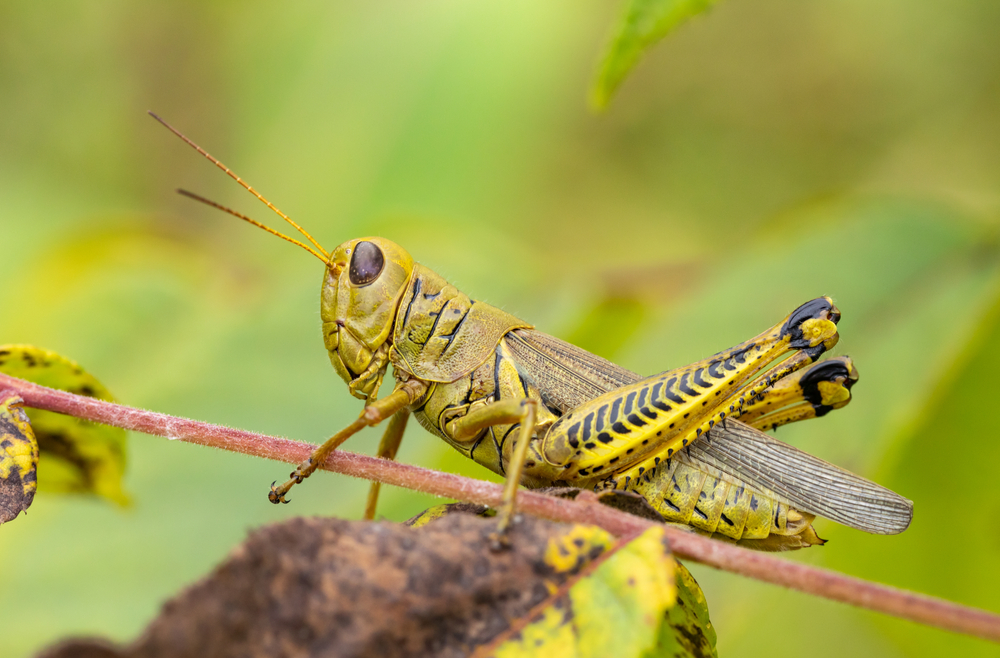
Identifying Characteristics and Facts
- They are about 1 – 1.5 inches long.
- Males are slightly smaller in body size than females.
- Has shades of brown or green for blending well in their environments.
- Fast moving with the ability to jump fast.
- Inhabit meadows, grasslands, and agricultural fields.
- Lay eggs in the soil that later hatch into nymphs as they grow into adults.
The differential grasshopper is one of the unique creatures that you will find in the habitats of Ohio or in other parts of the United States.
When it comes to size, this grasshopper usually ranges from 1 to 1.5 inches. It has shades of green or brown that help it blend in with its natural habitats such as grasslands, meadows, and agricultural fields.
The Differential Grasshopper eats a variety of plants which can make it a potential problem for agriculture. Of course, their numbers in agricultural farms may cause losses since they can cause significant damage to crops.
Its population dynamics are influenced by factors like temperature, food availability, and predation. During the fall, female grasshoppers lay eggs in the soil that hatch into nymphs in the spring. These nymphs go through molts before becoming adults during the summer.
Although the Differential Grasshopper plays a role in ecosystem dynamics and food chains, its large numbers as I have mentioned, and the fact that they consume plants can pose great challenges to agriculturalists.
#2. Red-Legged Grasshopper (Melanoplus femurrubrum)
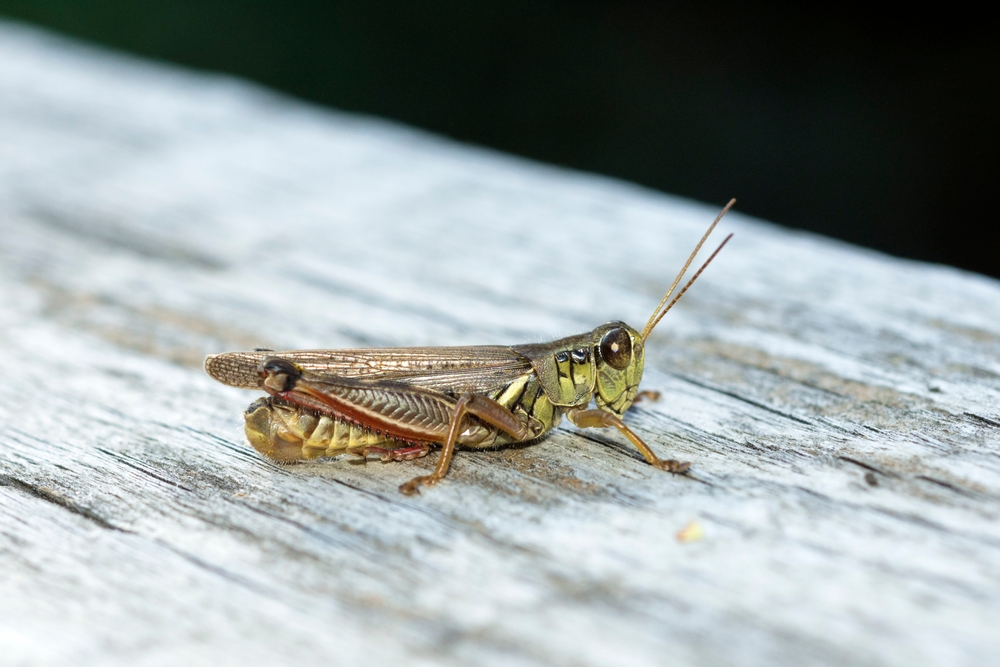
Identifying Characteristics and Facts
- They have large hind legs.
- Usually about 1 to 1.5 inches in body size.
- Have a color variation from green to brown.
- Eat various grasses, shrubs, and other crops.
- Usually undergo incomplete metamorphosis where the egg hatches into a nymph.
- They usually lay their eggs in the soil.
The Red-Legged Grasshopper is one of the common types of grasshopper in Ohio or surrounding areas.
This particular species is easily recognizable by its red hind legs which serve as a distinguishing characteristic. When fully grown, the adults usually measure between 1 to 1.5 inches in length and display color variations from green to brown allowing them to blend in with their surroundings.
It is also worth to understand that this grasshopper is known for its diet. It consumes a variety of plant species such as grasses, crops, and shrubs. While their feeding habits can bring benefits by helping regulate plant populations, they can also pose concerns due to potential damage to agricultural crops.
Red Legged Grasshoppers also undergo a metamorphosis process that includes stages of eggs, nymphs and finally reaching adulthood.
During the fall season, females lay groups of eggs in soil which then hatch during the spring. As nymphs grow and develop through molts they gradually transform into adult individuals.
In most regions of the world including Ohio, the Red Legged Grasshoppers are considered pests due to their potential for causing crop damage. However, they also play a role in ecosystems as a valuable food source for various predators.
#3. Green-Legged Grasshopper (Melanoplus viridipes)
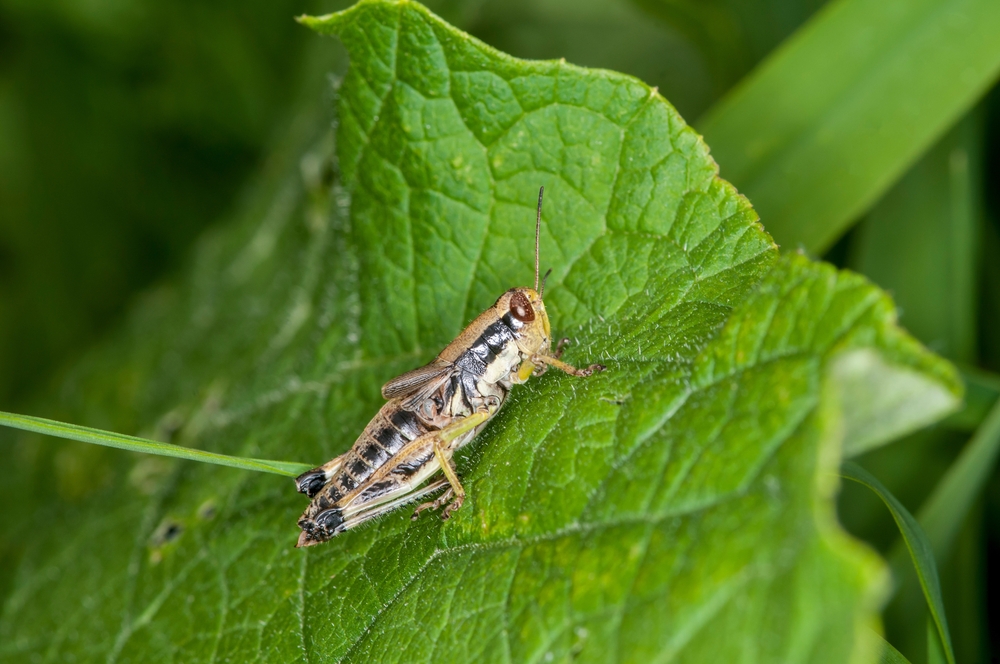
Identifying Characteristics and Facts
- They are about 1 – 1.5 inches in body size.
- Varying colors from brown to green for a better blend in the environment.
- Dwell in meadows, open areas, and grasslands among other habitats.
- Lay their eggs in the soil.
- Known for the melodious sounds they produce by rubbing their hind legs against the wings.
The green-legged grasshopper is another type that is common in Ohio or all other regions of the world. This grasshopper species is usually measuring about 1 to 1.5 inches long. Its coloration can vary from brown to green allowing it to blend in well with its habitats.
When it comes to habitat, the green-legged grasshopper, just like most others is commonly found in meadows, grasslands, and open areas where it feeds on a variety of plants including grasses and other vegetation.
In regards to breeding information, these grasshoppers undergo stages in their life cycle; eggs, nymphs, and adults. They, therefore, do not undergo a complete metamorphosis. It is also good to know that they reproduce by laying eggs in the soil. The eggs will later hatch into nymphs that resemble versions of adults but without wings and are not yet sexually mature.
Green Legged Grasshoppers are a part of food webs as they serve as prey for birds, mammals, and other insects. Of course, this is one of the ecological importance they serve in their habitats.
Lastly, their ability to jump distances helps them evade predators effectively. Additionally, they are known for their singing produced by rubbing their hind legs against their wings.
#4. Two-Striped Grasshopper (Melanoplus bivittatus)
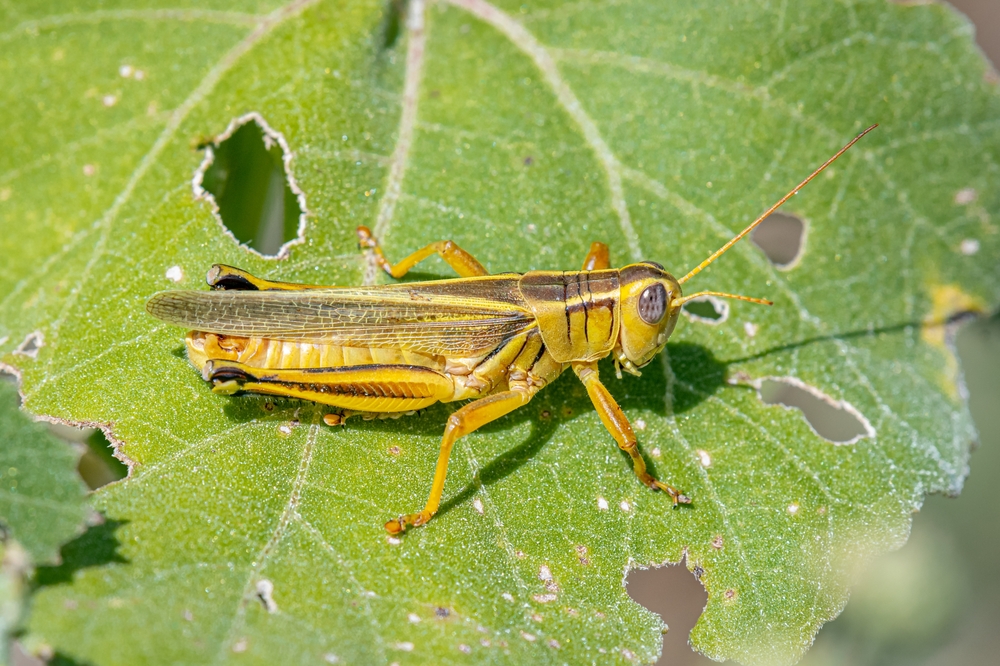
Identifying Characteristics and Facts
- About 1 – 1.6 inches long.
- Usually have varied colors ranging from green to brown.
- Has two stripes running along the body.
- Varying coloration from green to brown.
- They eat grasses and leaves of plants.
- Have incomplete metamorphosis.
You cannot talk about the types of grasshoppers in Ohio or surrounding areas without the mention of the two-stripped grasshopper. This one is common in gardens and also in various parts of the world.
This particular type of grasshopper is easily identifiable due to its appearance characterized by two stripes that run along its body. That is where its name comes from. Typically, these grasshoppers are 1 to 1.6 inches long. They can vary in color from green to brown which helps them blend in with their surroundings.
The two striped grasshoppers play some crucial roles within their ecosystems. They are herbivores and consume a variety of plants like grasses and leaves. They play a part in food chains by becoming prey for predators such as birds, reptiles, and other insects.
About their developmental stages, these grasshoppers have a life cycle that consists of three main stages; egg, nymph, and adult. The female grasshoppers lay their eggs in the soil during summer or early autumn. These eggs then hatch into nymphs in the spring season.
#5. Short-winged Grasshopper (Acrolophitus Ohioensis)
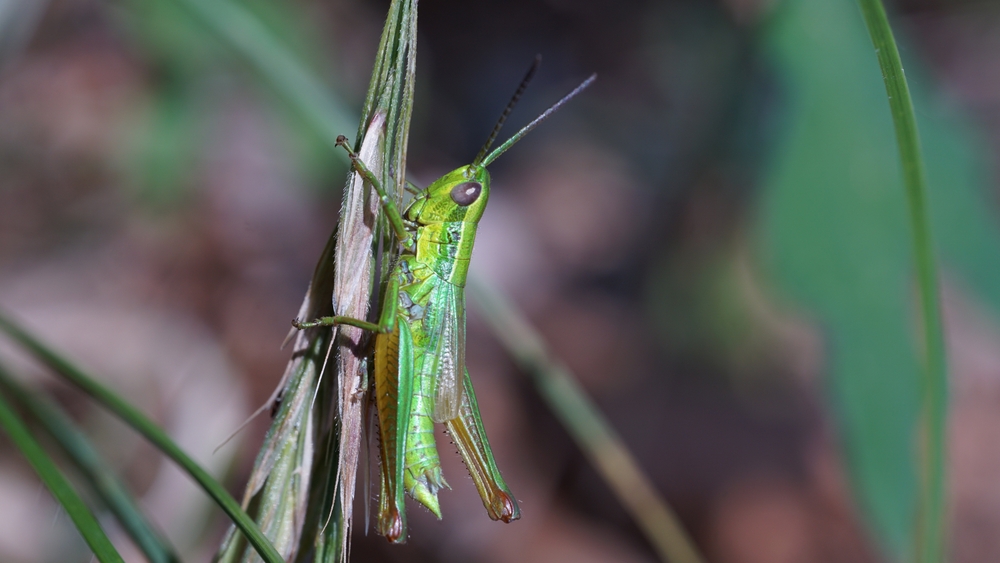
Identifying Characteristics and Facts
- Males usually differ in color from females.
- Have wings that are shorter than the abdomen and hence do not fly.
- Mainly eat grasses and plants.
- Males also differ in size from females.
- Cannot fly but can jump or blend into the environment to avoid predators.
The short-winged grasshopper is another type of grasshopper in Ohio or surrounding areas. It is well known for its wings and can often be found in grasslands, meadows, and open habitats. One notable feature of this insect is its wings, which are shorter than its abdomen and that prevent it from flying.
The short-winged grasshopper exhibits dimorphism, meaning that males and females differ in size and color. Their color can range from brown to green allowing them to blend in with their surroundings.
Because they cannot fly, they rely on methods for defense and escape including jumps and blending into their environment. This helps them avoid or escape their predators.
It is also important to know that these grasshoppers face threats from birds, reptiles, mammals, and other predators. Their life cycle is incomplete and involves stages where the eggs hatch into nymphs that resemble adults and gradually mature through several molting stages.
#6. Carolina Grasshopper (Dissosteira carolina)
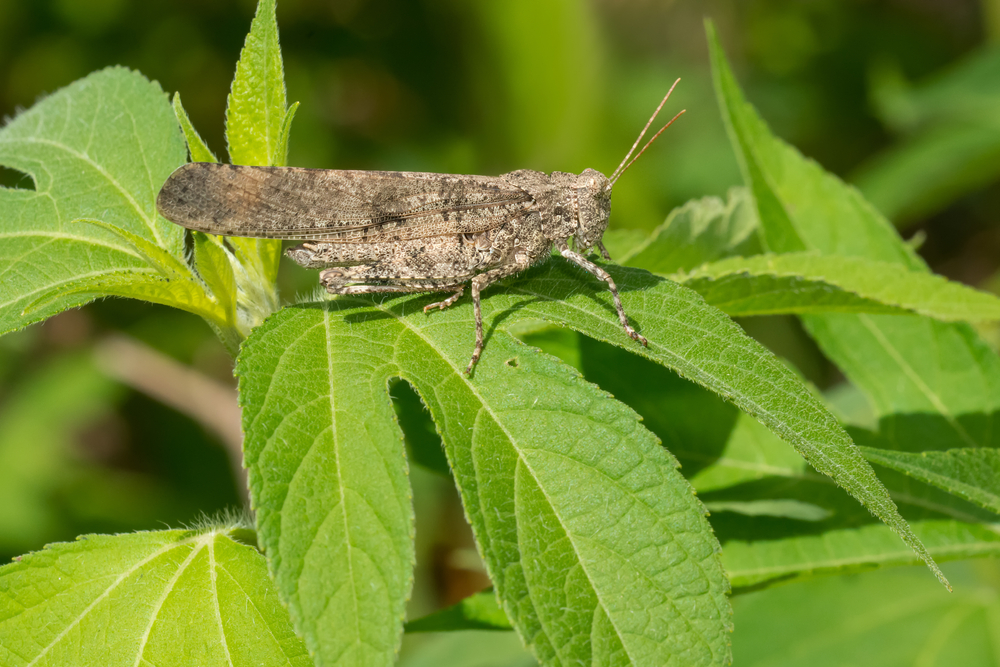
Identifying Characteristics and Facts
- They are about 1.5 – 2 inches long.
- Has hues of yellow and brown when they are in their adult stages.
- Has well-developed hind legs for jumping.
- Also has a pair of wings they use to produce buzzing sounds.
- Feed on vegetation, grasses, and leaves.
The Carolina Grasshopper, also known as Dissosteira carolina is a well-distributed and sizable species found throughout North America and is also a type that is common in Ohio.
It stands out due to its colors and notable size playing a role in local ecosystems. With a length ranging from about 1.5 to 2 inches, the Carolina Grasshopper has hues of brown and yellow colors when in adulthood.
It also possesses developed hind legs that are specially adapted for jumping and two sets of wings. Interestingly, the buzzing sound produced by their hind wings during flight is quite distinctive and that sets them apart from other types of grasshoppers.
As herbivores, the Carolina Grasshoppers primarily feed on plants such as grasses and other vegetation. While their feeding habits can impact the vegetation around them, they also serve as a source of food for predators including birds, reptiles, and mammals.
During the mating season, the male Carolina Grasshoppers attract females through displays and acoustic signals combined. This species undergoes metamorphosis with three stages; egg, nymph, and adult. They usually deposit their eggs in the soil during summer or early fall and hatch into nymphs during springtime.
#7. Slant-Faced Grasshopper (Acrolophitus hirtipes)
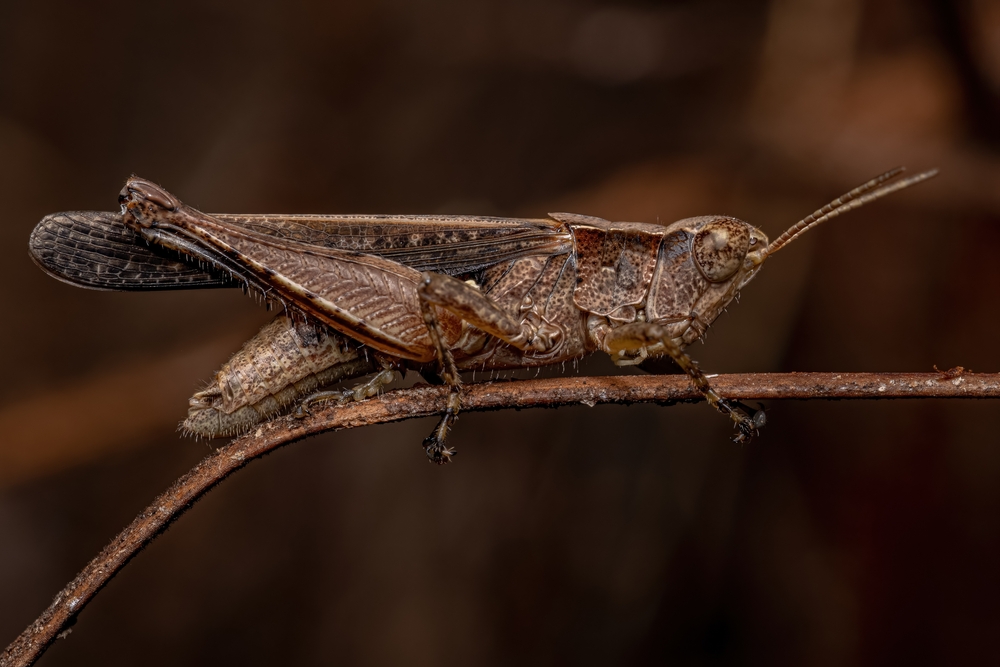
Identifying Characteristics and Facts
- They are about 1.5 – 2.5 inches in body size.
- Mainly eat grasses and leaves of plants.
- Has a slant or angled face.
- Herbivores usually eat grasses and leaves.
- Males produce special sounds that they use to attract females during mating.
- Lay eggs in soil and the eggs later hatch into nymphs and finally develop into adults.
The Slant-Faced grasshopper gets its name from the angle or slant on its face, which is located between the eyes and the top of its head. Of course, this is a distinctive feature that is not common in other types of grasshoppers.
When it comes to habitat, this type of grasshopper typically lives in grasslands, open woodlands, and agricultural fields. Its color can range from brown to green helping it blend in with its surroundings and hence can easily escape its predators.
It is also worthwhile to note that these grasshoppers are herbivores. They mainly feed on plants such as grasses and leaves. They also do play a role in the ecosystem as both a plant consumer and prey for predators contributing to the balance of the food chain.
During mating season, male Slant-Faced Grasshoppers produce sounds using their wings or other parts of their body to attract females. They engage in courtship rituals that involve displays and sound signals. After mating, females lay eggs in the soil that later hatch into nymphs as they develop into adults.
Although this species is not considered a threat to agriculture occasionally, their feeding habits can cause localized damage to plants and possibly loss especially when in their numbers.
As a reminder, the below factors are common for the most common grasshopper:
- Most can be found in your yard, garden, or neighborhood
- Most are not harmful to you or your pets. In fact, most are beneficial to the surrounding the ecosystem
- There are easy ways to attract and deter grasshoppers
- Most grasshoppers serve an important role in your garden and surrounding environment